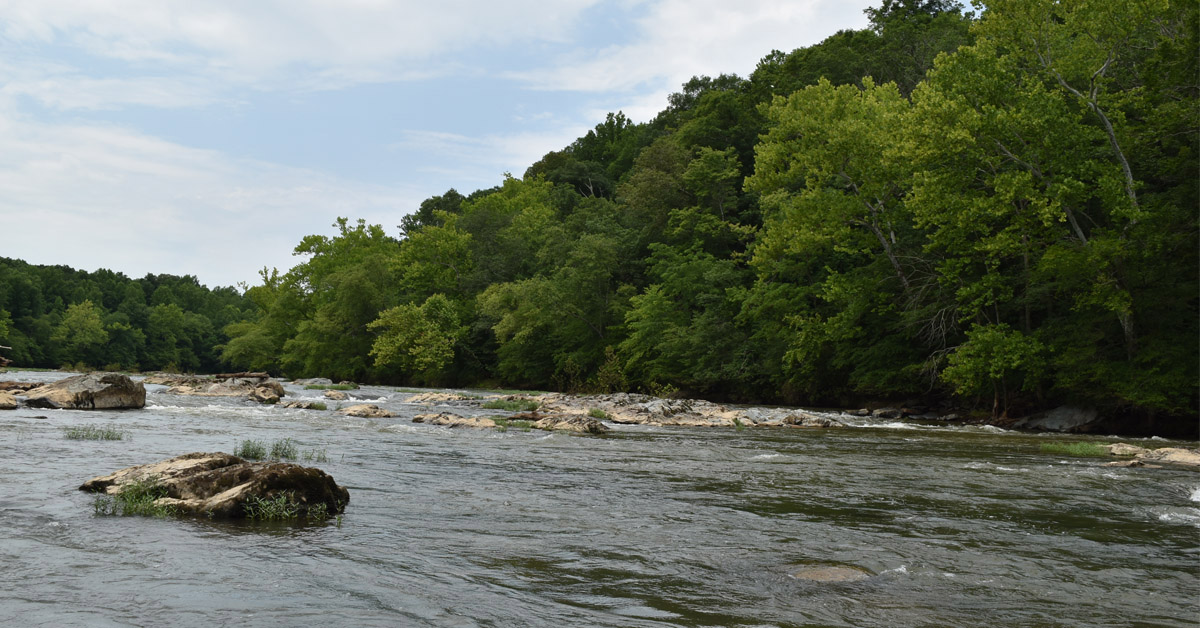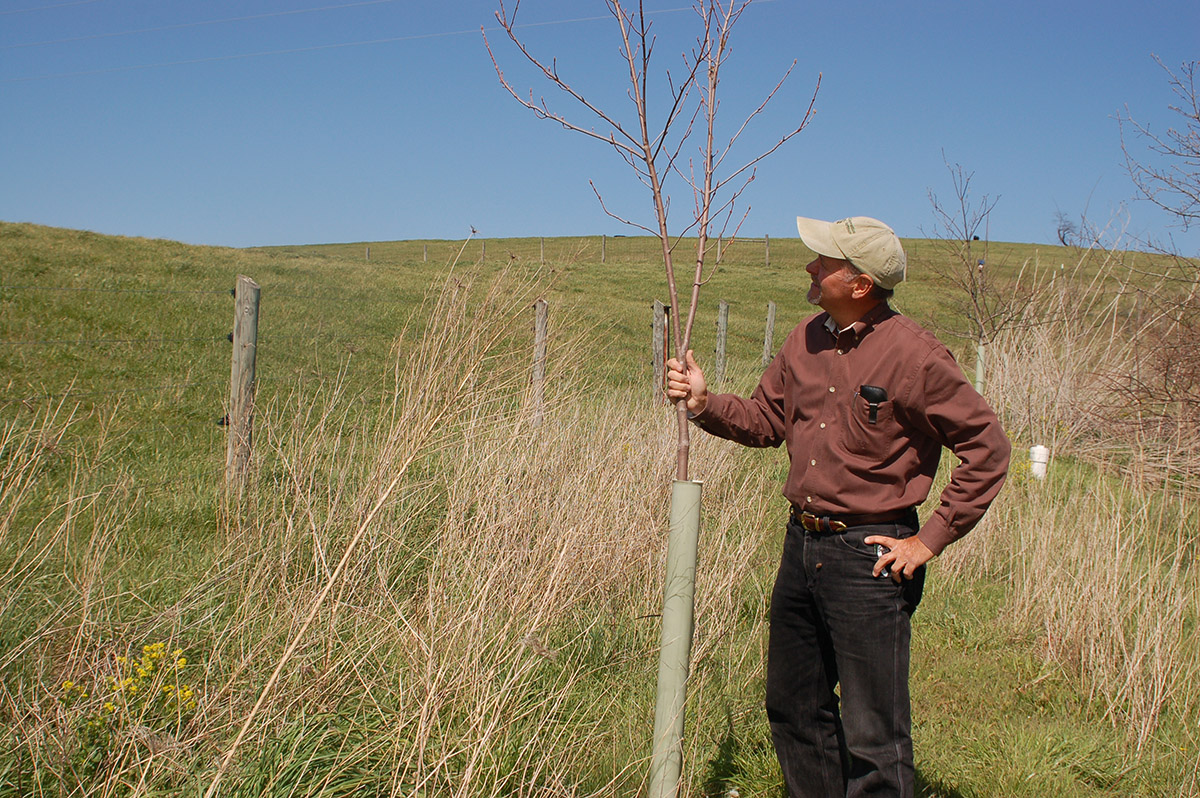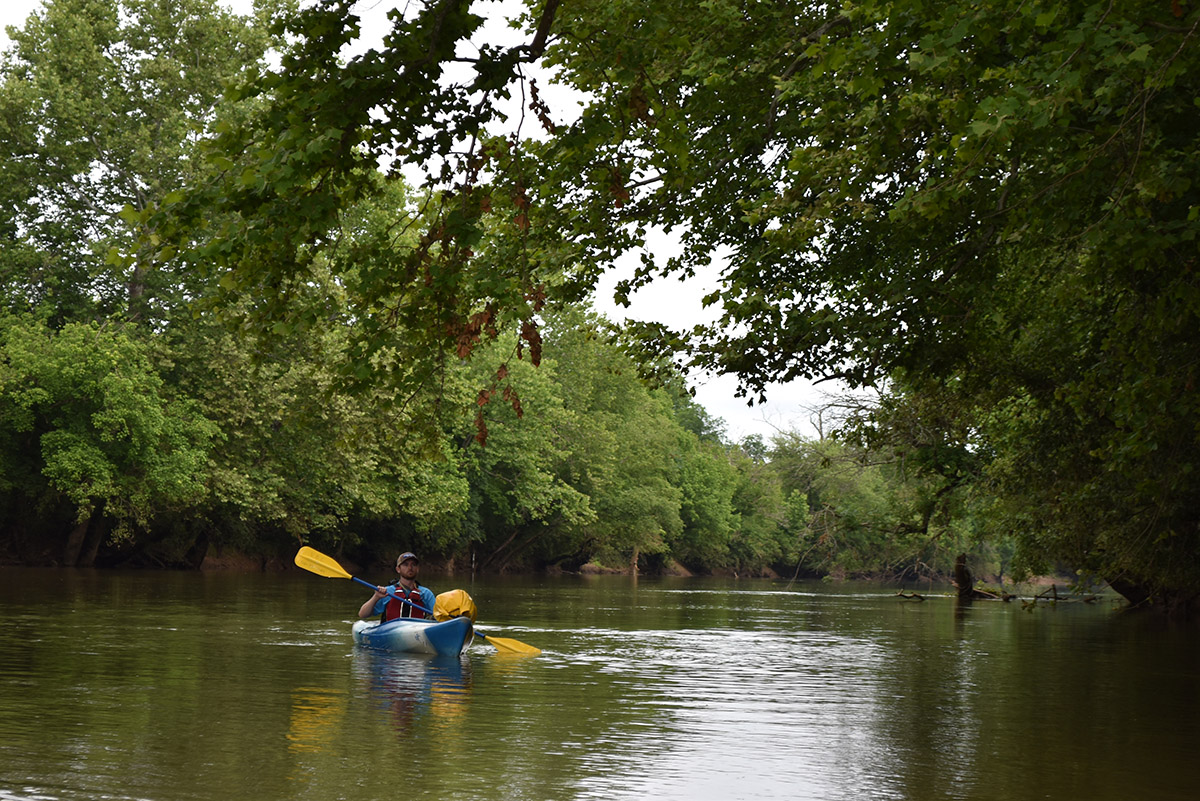
The VDWR and various Friends groups and other NGOs work cooperatively to improve the fishing and paddling experience on state rivers.
By Bruce Ingram
Photos by Bruce Ingram
The fisheries in many of Virginia’s best rivers are struggling right now. For example, smallmouth bass year class reproduction has been poor on the James and New in recent years. And last summer on the Shenandoah, the watershed’s algae problems occurred again. But river enthusiasts in the Old Dominion are fortunate to have NGOs (non-government organizations) working with the Department of Wildlife Resources (DWR) to improve matters.
DWR District Fisheries Biologist Steve Reeser praises the work of these groups.
“These NGOs play a pivotal role in advocating for the protection and improvement of water quality in Virginia’s waterways,” he said. “Water quality is the foundation for healthy aquatic ecosystems, and also helps determine our quality of life. DWR is responsible for managing recreational fisheries, and these organizations have contributed greatly to protecting and enhancing fish populations.
“The Department has a long history of partnering with these NGOs on various projects and programs. Together, we can accomplish much more in improving Virginia’s aquatic resources than working independently. In short, water quality is the building block toward having rivers people can fish, paddle, and recreate in. Without clean water, DWR can’t manage these waters for recreational fishermen,” Reeser continued.
Reeser added that a prime example of how NGOs and DWR partnered were the fish kills on the Shenandoah watershed during the first decade of this century. The Friends of the Shenandoah and the Friends of the North Fork of the Shenandoah were instrumental in working collaboratively with DWR as part of a fishery taskforce.
“Both organizations assisted with water monitoring of contaminants—beyond what they had been doing already,” Reeser said. “They also worked parallel with us and the [U.S. Geological Survey] (USGS). After all, everyone had the same goals—to have a healthy watershed.”
Friends of the Rappahannock
The Friends of the Rappahannock (FOR) works closely with DWR said Adam Lynch, river steward for the organization.
“Friends of the Rappahannock has been partnering with DWR and localities to improve river access,” he said. “This includes Fauquier County’s Upper Rappahannock Water Trail, which has successfully opened two new public access points and three new non-motorized boat launches along the Rappahannock. The Fauquier County Upper Rappahannock Water Trail was awarded the Governor’s Environmental Excellence Gold Medal.
“For the last several years, FOR has also been a partner with DWR and other partners including the Piedmont Environmental Council and Trout Unlimited on the Eastern Brook Trout Joint Venture. This program aims to restore cold-water streams to improve native brook trout habitat, with a special emphasis on removing barriers to fish movement in the upper Rappahannock watershed.”
Additionally, continued Lynch, FOR has volunteered with DWR on a number of electrofishing surveys over the past several years, assisting with DWR’s annual depletion surveys and brook trout population surveys.
FOR is also a key partner in the Headwater Stream Initiative program, alongside other partners including the Piedmont Environmental Council and Virginia Department of Forestry. This program is aimed at reforesting riparian areas, which improves water quality and aquatic habitat for a variety of fish and wildlife.

Adam Lynch of the Friends of the Rappahannock with a fine smallmouth he caught from the Rap. Efforts by NGOs help produce fishing like this.
Shenandoah Riverkeeper
Mark Frondorf has been the Shenandoah Riverkeeper since 2015, and he listed the following accomplishments of the organization during that time.
- Reduced the number of cattle herds directly accessing the river from 80 to single digits.
- Lobbied and convinced the Virginia General Assembly to pass a law that will require cattle herds to be removed from state rivers and perennial streams by the end of 2025. Cost share dollars are available for fencing and for farmers creating alternative watering sites.
- Twice sued the EPA to force the Virginia Department of Environmental Quality (DEQ) to do what is necessary to have the Shenandoah River placed on the Impaired Waters List for excessive algae.
- Celebrates Earth Day by removing trash from some 62 sites on the Shenandoah.
Frondorf adds that the support of DWR biologist Steve Reeser and the entire Verona staff has made the Riverkeeper program more effective.

Thanks to the efforts of Shenandoah River Keeper, scenes such as this are far less common these days on the Shenandoah watershed.
Chesapeake Bay Foundation
Peggy Sanner, the Virginia Executive Director of the Chesapeake Bay Foundation (CBF), says CBF works closely with scientists and regulators at DWR on a variety of issues at the intersection of water quality and wildlife including the following.
- Hosting workshops with DWR to bring partners together on restoration and protection of freshwater mussel initiatives.
- Developing a statewide tool to prioritize streamside vegetated buffer plantings in prime mussel habitat to help water quality.
- Developing 3-D replicas of freshwater mussels for public outreach and enhancing training courses.
“I’d also note that, while DWR does not (and cannot) do legislative advocacy, CBF has advocated to the General Assembly for increased funding at DWR to support the agency’s important work on freshwater mussels,” Sanner said. “We are hopeful that the Fiscal Year 2023-24 biennial budget will include additional funds for that work.”
Friends of the North Fork of the Shenandoah
Executive director David Brotman and the programing staff of the Friends of the North Fork of the Shenandoah River (FNFSR) support and protect the well-being of its namesake waterway and its tributaries by doing the following:
- Engaging the North Fork Watershed’s residents and visitors in understanding their roles in the health of the river and its wildlife.
- Enlisting scores of regional volunteers in monitoring and improving the health of the river.
- Collaborating with federal and state agencies (such as DWR) and regional land trusts and NGOs to improve water quality through conservation easements and best management practices.
- Developing and delivering innovative cross-disciplinary and experience-based educational programs for the region’s public and private school children.
- As Friends of Seven Bends State Park, provide open-to-the-public experiences, outdoor classes, volunteer opportunities, and demonstration initiatives.
“We all live in one watershed or another—wherever we live, water runs to a river and eventually to a bay or an ocean,” Brotman said. “We all affect water quality beyond our kitchen sinks. We, Friends of the North Fork, help our communities and supporters make a positive difference in the health of their local waters and the quality of the waters they send downstream.”

Today, on the Shenandoah watershed, more and more farmers (thanks to outreach by various NGOs, are planting riparian zone vegetation.
Friends of the Rivers of Virginia
Bill Tanger, chair of the Friends of the Rivers of Virginia, says FORVA has been involved in many issues dear to river enthusiasts, among them the following:
- Improving public access
- Improving water quality
- Removing dams
- Working to establish conservation issues to protect stream corridors and to create access.
- Developing riverside parks.
“One of our most recent projects was working with DWR to repeal a bill that charged public access fees for people to get on rivers,” Tanger says.

The banks of this part of the Rappahannock are under conservation easements, which help insures that this river will always offer quality paddling.
Friends of the Shenandoah River
Karen Anderson, laboratory and program director for Friends of the Shenandoah River, said her organization strives to provide sound scientific water quality data reflecting the health of the watershed. Objectives include the following:
- Assess health of local streams.
- Document changes in stream health over time.
- Prioritize sites for restoration efforts.
- Document successes and challenges of restoration efforts.
- Discover and document acute pollution problems.
- Help protect and preserve streams and stretches that can be considered reference streams.
- Identify sources of both non-point and point-source pollution that may help in Total Maximum Daily Load (TMDL) development.
James River Association
Bill Street, president of the James River Association (JRA), states that the organization works with DWR in many ways to protect the James River and to connect people to it. Those activities include the following:
- Working to develop a recovery plan for American shad on the James River.
- Increasing river access for the public.
- Restoring freshwater mussels to the James River and its tributaries.
- Removing barriers to fish passage for river herring, shad, and eels.
These NGOs operate off grants and donations, and one way recreationists can make a difference is to donate to them as well as to the DWR’s Restore the Wild initiative, which provides funds directly to DWR wildlife habitat restoration and creation projects. Reeser said supporting these organizations and DWR is a way for citizens to become involved directly with those who are striving to restore our waterways.


